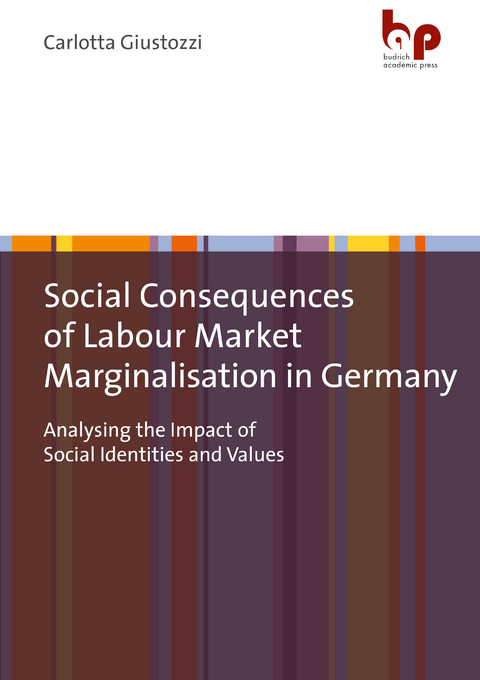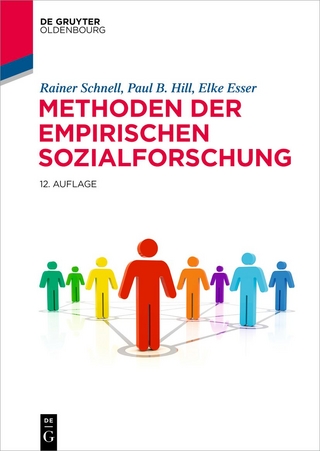Social Consequences of Labour Market Marginalisation in Germany
Budrich Academic Press (Verlag)
978-3-96665-055-7 (ISBN)
lt;b>Carlotta Giustozzi, research assistant, institute of sociology at Goethe University Frankfurt/Main, Germany.
1. Introduction - The Relationship of Labour Market Marginalisation and Social Exclusion
1.1 Scientific Evidence and Main Expectations about the Effects of Labour Market Marginalisation on Social Integration
1.2 Conceptual Framework and Analytical Approach
1.3 The Setup of the Empirical Analysis
1.4 Three Dimensions of the Labour Market and Social Exclusion Relationship
1.5 Overview of the Thesis
2 Conceptualising Labour Market Marginalisation and Social Integration
2.1 Determinants of Social Exclusion
2.1.1 Multidimensionality of Social Exclusion
2.1.2 Two Spheres of Sociability
2.2 Making Sense of the Multi-Layered Functions of Employment
2.2.1 Materialist Perspectives on Labour Market Disadvantage
2.2.2 Social Identity Perspectives on Labour Market Disadvantage
2.2.3 The Context's Influence on Individual Labour Market Experiences
2.2.4 Interrelation of Financial Distress and Identity Struggles
2.3 Dynamics of Labour Market Marginalisation
2.3.1 The Cumulative Tendency of Disadvantage
2.3.2 Social Class, Vulnerability, and the Distribution of Labour Market Risks
2.4 Summary
3 Data and Methods
3.1 A Combined Longitudinal and Multi-level Data Set
3.2 Sample
3.3 Data Challenges - Non-response and Missing Values
3.4 Operationalisation of Core Concepts
3.4.1 Explaining the Labour Market Marginalisation and Social Exclusion Link
3.4.2 Contextualising Individual Labour Market Experiences
3.5 Methodological Considerations - Modelling Longitudinal and Hierarchical Data
4 Accumulation of Labour Market Disadvantage - Individual, Household, and Regional Factors
4.1 Path Dependency - The Cumulative Process of Disadvantage
4.1.1 Explaining Cumulative Tendencies of Disadvantage - the Impact of Resources and Social Roles
4.1.2 Gender, Partnership and Household Composition - How Social Roles Reinforce Labour Market Positions and Trajectories
4.1.3 Context Factors - the Impact of Regional Labour Markets, Wealth, Demography, and Institutional Settings
4.2 Analytical Strategy and Operationalization
4.3 The Impact of Employment Histories, Favourable and Harmful Contexts
4.3.1 Accumulation of (Dis-) Advantage - the Intensification of Effects
4.3.2 Social Roles Determine Female Vulnerability to Labour Market Marginalisation
4.3.3 Regional Labour Markets, Fertility Rates, and Childcare Availability Have a Greater Impact on Female than Male Labour Market Outcomes
4.4 Concluding Remarks on the Accumulation of Labour Market Marginalisation
4.5 Appendix
5 Labour Market Marginalisation and Social Embeddedness: Unravelling the Conditions for Deteriorating Personal Relations
5.1 Taking Multidimensional Linkages of Labour Market Disadvantage and Social Relations into Account
5.1.1 Gendered Effects of Labour Market Marginalisation
5.1.2 Age Dependent Vulnerability to Negative Labour Market Experiences
5.1.3 Linked Lives - Labour Market Marginalisation in the Household Context
5.1.4 Assessing the Spatial Dimension of Individual Labour Market Experiences
5.1.5 Summary
5.2 Analytical Strategy and Operationalization
5.3 Exploring the Four Social-Structural Dimensions of Inequality
5.3.1 Gendered Patterns of Labour Market Disadvantage
5.3.2 Labour Market Disadvantage at Different Life Stages
5.3.3 The Unexpected Weak Effect of Household Composition for Labour MarketDisadvantage
5.3.4 Contextualizing Individual Labour Market Experiences - Assessing the Impact of Regional Labour Markets, Prosperity, and Fertility
5.3.5 Examining Attitudinal Dimensions of Social Identity
5.4 Concluding Remarks on the Effects of Labour Market Marginalisation on Personal Relations
5.5 Appendix
6 Labour Market Marginalisation and Public Engagement: Unravelling the Conditions for Withdrawal from Civic Participation
6.1 Defining Civic Participation as Social, Religious, and Political Engagement
6.2 Structural and Socio-Cultural Explanations of the Labour Market and Civic Participation Relationship
6.2.1 Structural Accounts of the Labour Market and Participation Relationship
6.2.2 Identifying Explanations beyond Material Resources - the Impact of Social Roles and Identity
6.2.3 Opportunity Structures and Normative Settings - Impact Factors at the Regional Level
6.2.4 Summary
6.3 Analytical Strategy and Operationalization
6.4 Resources, Social Roles, and the Socio-Economic Context
6.4.1 The Accumulation of (Dis-) Advantage Intensifies the Effects of Labour Market Experiences
6.4.2 The Insignificance of Financial mechanisms
6.4.3 Work Norms and Family Values Strengthen Resilience to Labour Market Marginalisation
6.4.4 Left Behind - Individual Marginalisation in Disadvantaged Regions
6.4.5 Double Advantage - Stable Careers in Contexts with Strong Participation Norms
6.5 Concluding Remarks on the Effects of Labour Market Marginalisation on Civic Engagement
7 Conclusion
7.1 Three Analytical Layers Shape the Relationship of Labour Market Marginalisation and Social Integration
7.1.1 Double (Dis-) Advantage - Social and Economic Positions and Local Contexts Affect Individual Work Trajectories
7.1.2 A Threat to Personal Relationships - The Vulnerability of People Whose Identity Depends on Paid Labour
7.1.3 Social Identity, Available Time, and Family Values Shape the Effects of Labour Market and Civic Participation
7.2 Putting the Results in Perspective - Common Threads, Limitations, and Future Research Avenues
7.2.1 The Weak Explanatory Impact of Financial Strain
7.2.2 The Importance of Social Roles and Identity
7.2.3 The Impact of Local Contexts for Individual Experiences of Social Integration
7.2.4 The Multifaceted Role of Labour Market Participation for Social Integration
8 References
| Erscheinungsdatum | 28.06.2022 |
|---|---|
| Verlagsort | Leverkusen-Opladen |
| Sprache | englisch |
| Maße | 148 x 210 mm |
| Gewicht | 345 g |
| Themenwelt | Sozialwissenschaften ► Soziologie ► Empirische Sozialforschung |
| Sozialwissenschaften ► Soziologie ► Mikrosoziologie | |
| Schlagworte | accumulation of disadvantage • Akkumulationsprozesse • Arbeitsmarktmarginalisierung • bürgerliche Partizipation • Identitätstheorie • Mehrebenenanalyse • Multilevel analysis • regionale Einflussfaktoren • regional level • Social Exclusion • Social Identity Theory • Social participation • social roles • soziale Exklusion • soziale Rollen |
| ISBN-10 | 3-96665-055-X / 396665055X |
| ISBN-13 | 978-3-96665-055-7 / 9783966650557 |
| Zustand | Neuware |
| Haben Sie eine Frage zum Produkt? |
aus dem Bereich




